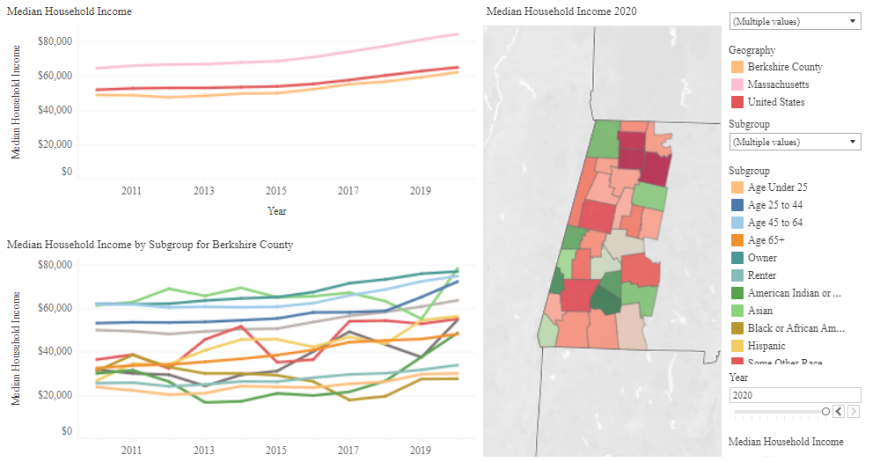The Berkshire Regional Planning Commission has released its Berkshire Benchmarks 2022 State of the County Report. It examines the successes and challenges the communities faces across eight sectors: Economy, Education, Environment, Government, Health, Housing, Social Environment, and Transportation.
The findings paint a complex portrait of the region, with a healthier environment and a stabilizing youth population on one hand and stark racial disparities in income and homeownership on the other. The commission hopes the report can influence public policy and community organizing in the county.
Geographic Information System Data and IT Manager Mark Maloy spoke with WAMC about how the report was compiled and what it shows.
MALOY: The data points we're looking at were determined through an extensive process over the last two years, really by members of the community. We had numerous meetings. Over 100 individuals and organizations were involved, and we ended up with around 80 indicators that we're looking at, we're going to start tracking year after year. These indicators are in a variety of sectors: economy and education, environment, there's housing and transportation. Some of the actual indicators in the sectors may be tracking meeting household income, or the number of acres of land protected, the miles of paved bikeways. So there's a number of measures that we're monitoring over time.
WAMC: In the summation of the report, you talk about the different broad categories of successes and challenges. Can you sort of take us through the successes that the Berkshire Regional Planning Commission has registered over what has seemed to many to be one of the more tumultuous periods of American history?
You know, the pandemic has definitely caused a lot of issues in our region, as with every other region out there, but we have seen some successes. Now, some of this data is actually from pre-COVID. So it may not be the current, up to date, but we're using the most current data available. We've been experiencing an increase in our income, we've seen a decrease in poverty and unemployment rates. Even with the COVID of unemployment, we've seen a decrease in unemployment rates. We have a healthier environment, our air pollution has been going down for the last one years. And then we also have seen an increase stability in the young adult population. This is a segment of our population aged 25 to 35 that we've been losing a lot of over the last several decades, and that seems to have stabilized. So there are some good things that we've been experiencing and that we were able to pull out of the data and show in the report.
What do you think speaks to what's keeping more young people in the Berkshires?
There's a lot of jobs available right now- Especially as baby boomers retire, there is just more availability for jobs. There has been an increased focus on attracting young adults, a lot of effort has been going into attracting and retaining people who would like a more rural lifestyle. There’s also more of an effort to look at outdoor recreation, which a lot of young adults would be more attracted to. So there's a variety of factors that may be going into that.
Now let's turn to the challenges. Break it down for us- Walk me through what the findings are when it comes to the things that Berkshire County is continuing to struggle with.
So there's a number of them. As with probably most regions, our children struggled academically during the pandemic. We can see that in the test results and enrollment issues. We know housing is getting less affordable to many low and middle income residents. Again, that's not a local issue. That's a national issue. But with our second home market, it's become even more of an issue here. We're also seeing behavioral health challenges. We see more mentally unhealthy days and a drastic increase in the opioid deaths in the county. We're seeing an increase in reports of families in distress, restraining orders, child requiring assistance filing. And then another one is kind of a cross sector item: We're really seeing a lot of differences and disparities in the data based on race and ethnicity. So just looking at the differences between the white population and the Black and other racial populations in the region.
What are some of the metrics where the disparity is most evident?
There's a couple that stand out to me. Median household income is very dramatic: The white population is two to three times higher median household income than the Black. The Black population has also seen a decline in median household income over the last 10 years, while the white population has seen over an 20% increase. Poverty: Whites have a very low poverty rate and Blacks are showing a higher poverty rate. Other races are mixed in between. Homeownership: We are seeing a very different picture based on homeownership. Whites, it's around 82% of white households own a home, while it's much much lower, it's only in the 20% for the Black population. So those are just three of them that stick out to me, but there's many more data points that are showing as well.
Now does the report come with any suggestions? Or is it just sort of more of, like, a “here's where we are now”?
This is really, here's where we are now. We're trying to use this as a baseline and monitor the data moving forward, and we're encouraging the community to look at this data, use this data, have it inform their decisions and what they do as an organization, as community members, as municipalities. And hopefully, collectively, they can come up with actions to help improve these things.
Were there any particularly surprising findings in the report that stand out to you?
So there’s two findings that really stood out to me when I looked at it. One was the young adult stability in that population. That was really good to see that become more stable. The other one was the disparity by race. We all knew that existed, but see the magnitude of it was really eye opening experience.
Do you have a sense at this point of what contributed to the general improvement of the Berkshire climate that the report found?
I think that air quality has seen improvements. A lot of that is from national policies and regulations. You know, it could be reduction in pollutants outside of the county just aren't getting into our county anymore.
What were the findings about housing in the Berkshires? That's been a big topic of conversation of late.
There's really a lack of moderate income housing, is what the data showed, but a lot of the data is actually from before the pandemic or right as a pandemic started. We know that housing prices have skyrocketed here, and low income as well as moderate income residents are having trouble finding housing. So it's really that, you know, moderate and low income populations are struggling.






